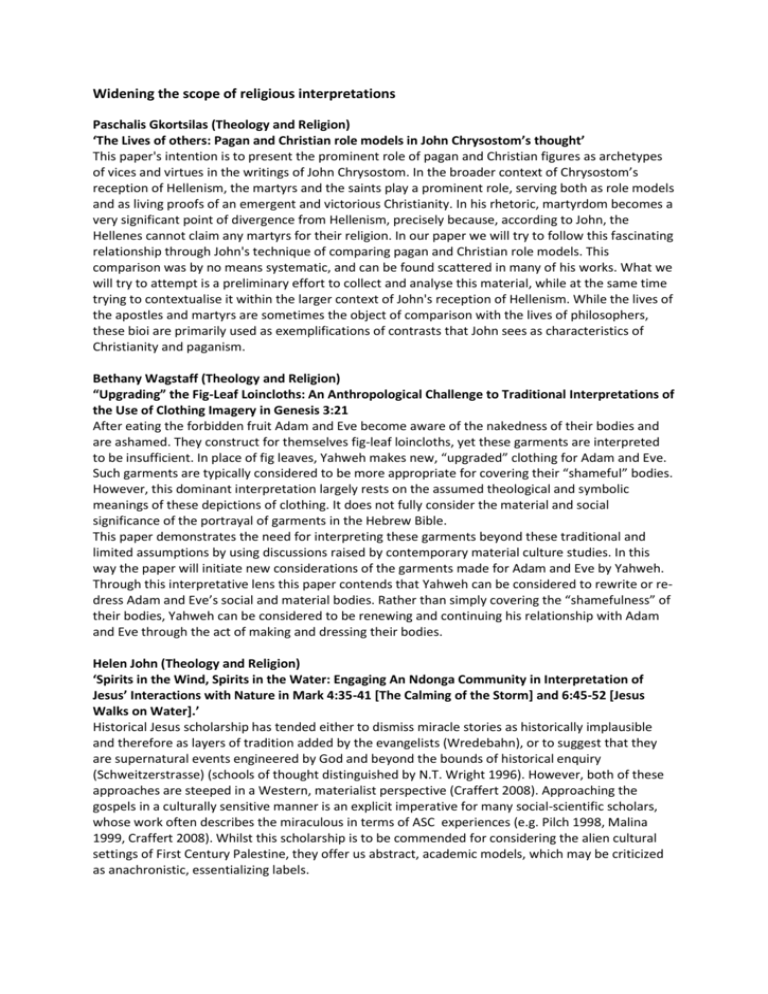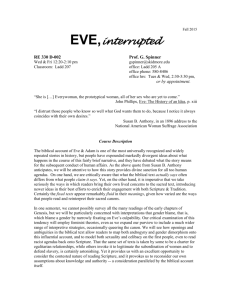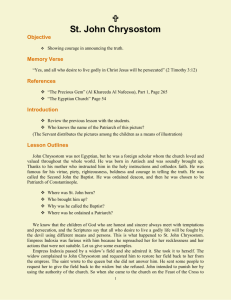Widening the scope of religious interpretations
advertisement

Widening the scope of religious interpretations Paschalis Gkortsilas (Theology and Religion) ‘The Lives of others: Pagan and Christian role models in John Chrysostom’s thought’ This paper's intention is to present the prominent role of pagan and Christian figures as archetypes of vices and virtues in the writings of John Chrysostom. In the broader context of Chrysostom’s reception of Hellenism, the martyrs and the saints play a prominent role, serving both as role models and as living proofs of an emergent and victorious Christianity. In his rhetoric, martyrdom becomes a very significant point of divergence from Hellenism, precisely because, according to John, the Hellenes cannot claim any martyrs for their religion. In our paper we will try to follow this fascinating relationship through John's technique of comparing pagan and Christian role models. This comparison was by no means systematic, and can be found scattered in many of his works. What we will try to attempt is a preliminary effort to collect and analyse this material, while at the same time trying to contextualise it within the larger context of John's reception of Hellenism. While the lives of the apostles and martyrs are sometimes the object of comparison with the lives of philosophers, these bioi are primarily used as exemplifications of contrasts that John sees as characteristics of Christianity and paganism. Bethany Wagstaff (Theology and Religion) “Upgrading” the Fig-Leaf Loincloths: An Anthropological Challenge to Traditional Interpretations of the Use of Clothing Imagery in Genesis 3:21 After eating the forbidden fruit Adam and Eve become aware of the nakedness of their bodies and are ashamed. They construct for themselves fig-leaf loincloths, yet these garments are interpreted to be insufficient. In place of fig leaves, Yahweh makes new, “upgraded” clothing for Adam and Eve. Such garments are typically considered to be more appropriate for covering their “shameful” bodies. However, this dominant interpretation largely rests on the assumed theological and symbolic meanings of these depictions of clothing. It does not fully consider the material and social significance of the portrayal of garments in the Hebrew Bible. This paper demonstrates the need for interpreting these garments beyond these traditional and limited assumptions by using discussions raised by contemporary material culture studies. In this way the paper will initiate new considerations of the garments made for Adam and Eve by Yahweh. Through this interpretative lens this paper contends that Yahweh can be considered to rewrite or redress Adam and Eve’s social and material bodies. Rather than simply covering the “shamefulness” of their bodies, Yahweh can be considered to be renewing and continuing his relationship with Adam and Eve through the act of making and dressing their bodies. Helen John (Theology and Religion) ‘Spirits in the Wind, Spirits in the Water: Engaging An Ndonga Community in Interpretation of Jesus’ Interactions with Nature in Mark 4:35-41 [The Calming of the Storm] and 6:45-52 [Jesus Walks on Water].’ Historical Jesus scholarship has tended either to dismiss miracle stories as historically implausible and therefore as layers of tradition added by the evangelists (Wredebahn), or to suggest that they are supernatural events engineered by God and beyond the bounds of historical enquiry (Schweitzerstrasse) (schools of thought distinguished by N.T. Wright 1996). However, both of these approaches are steeped in a Western, materialist perspective (Craffert 2008). Approaching the gospels in a culturally sensitive manner is an explicit imperative for many social-scientific scholars, whose work often describes the miraculous in terms of ASC experiences (e.g. Pilch 1998, Malina 1999, Craffert 2008). Whilst this scholarship is to be commended for considering the alien cultural settings of First Century Palestine, they offer us abstract, academic models, which may be criticized as anachronistic, essentializing labels. It is claimed that the worldviews of biblical societies share qualities with contemporary ‘traditional,’ agrarian communities. This study set out to engage one such community in biblical interpretation, in order to add voices to the usually book-based endeavour that is cross-cultural biblical scholarship. Presented in this paper are some of the results from a year’s fieldwork in Namibia, in which the author conducted participant-observation alongside Contextual Bible Studies in the Ondonga area. The combination of ethnographic study with contextual biblical interpretation means that the process of gospel scholarship is democratized and the author is able to reach beyond her own Western, ontologically monist worldview. With regard to Mark 4:35-41 and 6:45-52, the CBS groups interpreted Jesus calming the storm and walking on water with recourse to their spirit-infused reality. From their point of view, the texts could be taken at face value, and their interpretations challenge the findings of traditional historical Jesus scholarship, as well as the models of the socialscientific approaches. Bibliography: Craffert, Pieter F. (2008): The Life of a Galilean Shaman: Jesus of Nazareth in AnthropologicalHistorical Perspective. Cambridge: James Clarke & Co. Malina, Bruce J. (1999): ‘Assessing the Historicity of Jesus’ Walking on the Sea: Insights from CrossCultural Social Psychology,’ pp.351-371 in Chilton, Bruce & Craig A. Evans (eds.): Authenticating the Activities of Jesus. Leiden: Brill. Pilch, John J. (1998): ‘A Window onto the Biblical World: Walking on the Sea,’ The Bible Today 36, 117-23. Wright, N.T. (1996): Jesus and the Victory of God. Minneapolis: Fortress Press.











